Thermally conductive pastes, adhesives, compounds and insulating thermal interfaces — purpose and application
To improve the quality of heat transfer from a surface that needs to be effectively cooled to a device designed to recover this heat, so-called thermal interfaces are used.
A thermal interface is a layer, usually of a multi-component thermally conductive compound, usually a paste or compound.
The most popular thermal interfaces today are those used for microelectronic components in computers: for processors, for video card chips, etc. Thermal interfaces are widely used in other electronics, where power circuits also experience high heating and therefore need efficient and high-quality cooling... Thermal interfaces are also applicable in all types of heat supply systems.
In one way or another, various thermally conductive compounds are used in the production of power electronics, radio electronics, computing and measuring equipment, in devices with temperature sensors, etc., that is, where there are usually components heated by the operating current or by some other way.with great heat dissipation. Today there are thermal interfaces of the following forms: paste, glue, compound, metal, gasket.
Heat transfer paste
Thermal paste or simply thermal paste is a very common form of modern thermal interface. It is a multi-component plastic mixture with good thermal conductivity. Thermal pastes are used to reduce the thermal resistance between two contact surfaces, for example between a chip and a heatsink.
Thanks to the thermally conductive paste, the air with its low thermal conductivity between the radiator and the cooled surface is replaced by a paste with significantly higher thermal conductivity.
The most common Russian-made pastes are KPT-8 and AlSil-3. Zalman, Cooler Master and Steel Frost pastes are also popular.
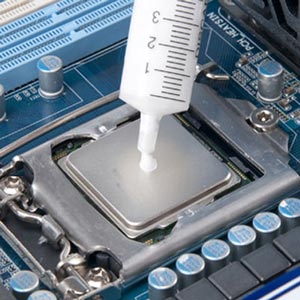
The main requirements for the thermally conductive paste are that it has the lowest possible thermal resistance, that it stably retains its properties over time and throughout the entire range of working temperatures, that it is easy to apply and wash off, and in some cases it is useful that there are suitable electrical insulating properties.
The production of thermally conductive pastes is related to the use of the best thermally conductive components and fillers with sufficiently high thermal conductivity.
Microdispersed and nanodispersed powders and mixtures based on tungsten, copper, silver, diamond, zinc and aluminum oxide, aluminum and boron nitride, graphite, graphene, etc.
The binder in the composition of the paste can be mineral or synthetic oil, various mixtures and liquids of low volatility. There are thermal pastes whose binder is polymerized in air.
It happens that in order to increase the density of the paste, easily vaporized components are added to its composition so that when applied the paste is liquid and then turns into a thermal interface with high density and thermal conductivity. Thermal conductivity compositions of this type have the characteristic property of reaching maximum thermal conductivity after 5 to 100 hours of normal operation.
There are metal-based pastes that are liquid at room temperature. Such pastes consist of pure gallium and indium, as well as alloys based on them.
The best and most expensive pastes are made of silver. Pastes based on aluminum oxide are considered optimal. Silver and aluminum give the lowest thermal resistance of the final product. Ceramic-based pastes are cheaper, but also less effective.
The simplest thermal paste can be made by mixing the lead powder of an ordinary graphite pencil rubbed on sandpaper with a few drops of mineral lubricating oil.
As noted above, a common use of thermal paste is as thermal interfaces in electronic devices where needed and applied between a heat generating element and a heat dissipating structure, for example between a processor and a cooler.
The main thing to observe when using thermally conductive paste is to keep the thickness of the layer to a minimum. To achieve this, it is necessary to strictly follow the recommendations of the manufacturer of the paste.
A little paste is applied to the thermal contact area of the two parts and then simply crumbled while pressing the two surfaces together. Thus, the paste will fill the smallest pits on the surfaces and will contribute to the formation of a homogeneous environment for the distribution and transfer of heat to the outside.
Thermal grease is good for cooling various assemblies and components of electronics, the heat release of which is higher than permissible for a certain component, depending on the type and characteristics of a particular case. Microcircuits and transistors of switching power supplies, linear scanners of picture lamp devices, power stages of acoustic amplifiers, etc. They are common places to use thermal paste.
Heat transfer adhesive
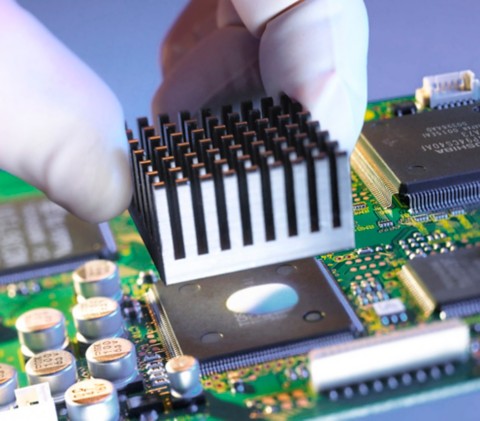
When the use of heat-conducting paste is impossible for some reason, for example, due to the inability to tightly press the components to each other with fasteners, they resort to the use of heat-conducting glue. The heatsink is simply glued to the transistor, processor, chip, etc.
The connection turns out to be inseparable, therefore it requires a highly precise approach and compliance with the technology for correct and high-quality gluing. If the technology is violated, the thickness of the thermal interface may turn out to be very large and the thermal conductivity of the joint will deteriorate.
Thermally conductive potting mixes
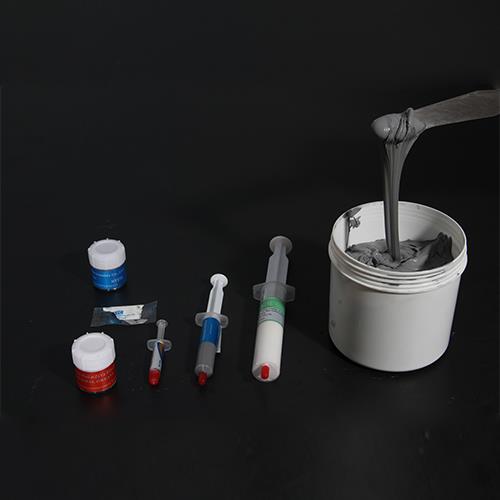
When, in addition to high thermal conductivity, hermeticity, electrical and mechanical strength are required, the cooled modules are simply filled with a polymerizable mixture, which is designed to transfer heat from the heated component to the device housing.
If the cooled module must dissipate a lot of heat, then the compound must also have sufficient resistance to heating, thermal cycling, and be able to withstand the thermal stress resulting from the temperature gradient inside the module.
Low melting metals
Thermal interfaces are gaining more and more popularity based on soldering two surfaces with a low-melting metal. If the technology is applied correctly, it is possible to obtain record low thermal conductivity, but the method is complex and carries many limitations.
First of all, it is necessary to qualitatively prepare the mating surfaces for installation, depending on their material, this can be a difficult task.
In high-tech industries, it is possible to solder any metals, despite the fact that some of them require special surface preparation. In everyday life, only metals that lend themselves well to tinning will be qualitatively bonded: copper, silver, gold, etc.
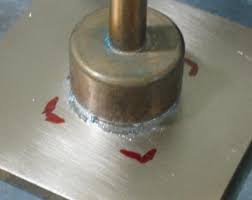
Ceramics, aluminum and polymers do not lend themselves to tinning at all, with them the situation is more complicated, here it will not be possible to achieve galvanic isolation of the parts.
Before starting soldering, the future surfaces to be joined must be cleaned of any dirt. It is important to do it effectively, to clean it from traces of corrosion, because at low temperatures fluxes will generally not help.
Cleaning is usually done mechanically using alcohol, ether or acetone. It is for this that a hard cloth and an alcohol wipe are sometimes present in the thermal interface package.The work must be done with gloves, since the grease that can be obtained from the hands will certainly deteriorate the quality of the soldering.
The soldering itself must be done with heating and compliance with the strength specified by the manufacturer. Some of the industrial thermal interfaces require mandatory pre-heating of the connected parts to 60-90 °C and this can be dangerous for some sensitive electronic components. Initial heating is usually done with a hair dryer, and then soldering is completed by self-heating of the working device.
Thermal interfaces of this type are sold in the form of glory foil with a melting point slightly above room temperature, as well as in the form of pastes. For example, Fields' alloy in the form of foil has a melting point of 50 ° C. Galinstan in the form of a paste melts at room temperature. Unlike foil, pastes are more difficult to use because they have to be very well embedded in the surfaces to be soldered, while foil only requires proper heating during assembly.
Insulation gaskets
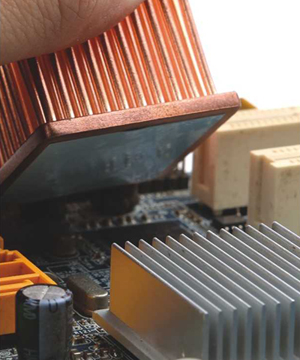
In power electronics, electrical isolation between heat transfer and heat sink elements is often required. Therefore, when thermally conductive paste is not suitable, silicone, mica or ceramic substrates are used.
Flexible soft pads are made of silicone, hard pads are made of ceramic. There are printed circuit boards based on a copper or aluminum sheet covered with a thin layer of ceramic, on which traces of copper foil are applied.
Usually these are single-sided boards, on one side of the track, and on the other there is a surface for attachment to the radiator.
In addition, in special cases, power components are produced in which the metal part of the housing, which is attached to the radiator, is immediately covered with a layer of epoxy.
Features of the use of thermal interfaces
When applying and removing the thermal interface, it is necessary to strictly follow the recommendations of its manufacturer, as well as the manufacturer of the cooled (cooling) device. It is important to be especially careful when working with electrically conductive thermal interfaces, as its excess can get into other circuits and cause a short circuit.
